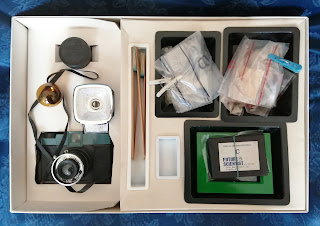Waddington’s Future Scientist Flash Photography
Once more we’re time travelling back to the 1960’s, this time to another Christmas Present long gone and replaced from a well known on line auction site in quite good condition
Simple black and white photography in the form of a educational toy
CAMERA
The Kit contained the following
1, A Diana 120 roll film Camera, with flash attachment for Flash Bulbs
I believe they did a cheaper set with NO flash
2, 1 x roll of 120 Film
3, 1 x Small thermometer
4, 3 x packets of Chemical A , which I believe was ILFORD ID-11 Developer
5, 3 x Packets of Chemical B, Sodium Thiosulphate Pentahydrate
Better known as “Hypo” fixer solution
6, 2 x Small Packets marked C , Photographic paper
7, 2 x Large Chemical trays and one small Chemical tray for Developer Wash and Fix
8, 1 x Small Plastic Exposure frame
9, 2 large Wooden Tongs , for holding the film or paper whilst developing
10, 2 x small Plastic clips
11, 1 x small 15W safety lamp
12, Instruction leaflet, (Lost)
Focus
The Focus is continuously variable with 3 setting points 4ft to 6ft - 6ft to 12 ft & 12 ft- inf
Shutter has two settings B and I ,
The “B” setting holds the Shutter open for Flash bulb or low light
The “I” setting opens the shutter for around 1/60 second
Iris – F stop
A basic but function adjustment with three Settings
Sunny – Sun & Cloud - Cloudy
and it does work quite well
Loading the Camera
Obviously a dark room would be best or Film loading bag,
I used to load my Camera under the bed sheets with the room curtains closed
Flash
The Flash uses standard PF style bulbs which are still available
It uses 2 pins to plug into the Camera
While the Gun hides the batteries inside
The little white plastic button ejects the spent Flash bulb
Top of the camera showing Flash socket
Comments
It worked well, I still have pictures to this day that have not faded with time
Timing and Temperature were the key
N.B. this is now part of my collection

















